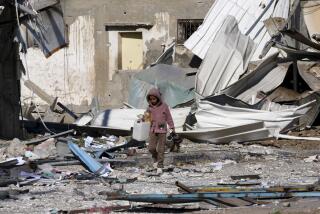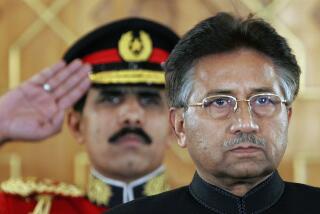Dollars to Help Pupils in Pakistan
- Share via
PESHAWAR, Pakistan — In a major injection of new aid, the United States is donating $100 million over five years to this nation’s troubled education system, including its religious schools, despite the fact that these so-called madrasas stand accused of breeding Islamic extremism.
A program being admini- stered by the U.S. Agency for International Development has been geared to focus on training teachers, reforming curricula and assisting in the formation of school “adoption” programs. Aid will be available to any school that demonstrates a capacity to raise literacy in a country where fewer than half of all adults can read and write.
The crisis in education in Pakistan is blamed for a host of social and economic ills, including unemployment, accelerating population growth and terrorism.
But the USAID program is getting underway even as the government of President Pervez Musharraf is under fire for not clamping down hard enough on the madrasas, a handful of which supplied leaders and foot soldiers for the Taliban, the hard-line Islamic government in neighboring Afghanistan that played host to Al Qaeda and Osama bin Laden before being driven from power by a U.S.-led coalition in late 2001.
A recent report by the International Crisis Group, a Brussels-based think tank, said the madrasas pose the same danger in turning out extremists that they did in the 1990s, when some graduates went on to fight jihads, or holy wars, against nonbelievers in Afghanistan and the disputed Kashmir region of India. According to the group, that danger has not abated despite promises by the Musharraf government to bring the schools to heel.
Other observers, however, say that the majority of this country’s 10,000 or so madrasas have been unjustly tarred by the Taliban brush and that the schools -- which educate about 10% of all Pakistani students -- fill a vacuum in a country whose educational infrastructure is, to put it mildly, a shambles.
Indeed, the USAID program and its mandate to assist Islamic schools as well as public and secular private schools reflect a widespread belief among educators and officials familiar with Pakistan: Madrasas serve a useful function.
“It’s unfortunate that some people think all madrasas are turning out extremists. The vast majority of them welcome secular courses like science and math and, we hope, will take advantage of teacher training and other programs that our new project will offer,” said Mark Ward, director of USAID’s mission in Pakistan.
To bring radical madrasas into the mainstream, education experts here seem to agree, aid has a better chance than enforced reorganization, so embedded are the religious schools in the country’s social and political fabric. And any aid would seem to be welcome in places such as Peshawar -- a bustling, dusty city of 1.8 million where half of all school-age children, especially girls, either stay at home or all but waste their time in one of Pakistan’s legions of “ghost” public schools, notorious for their largely absentee teachers, dearth of textbooks and patchy curricula.
Ziallulah, 10, depends on a madrasa for the scant education she can get. She goes to the run-down Darul Haffaz school on the outskirts of town because it’s the only one within three miles of her home that will take her. She studies a little English and math but mainly the Koran, hoping it will prepare her to work as a religious scholar or functionary.
“I am learning to recite the Koran by heart,” said the shy and veiled daughter of a Pakistani army soldier. That skill will qualify her to earn a little money reciting funeral rites for deceased women. But she personifies a common criticism of madrasas: They have little vocational value for their students.
Kashkul Ahmad is the principal of Ziallulah’s school, which includes 140 girls and 60 boys and offers free tuition and board to those who can’t afford to pay. Ahmad says 1,000 families in his neighborhood have no other option but to send their children to him. He says he’s “too busy teaching” the Koran and other subjects to worry about radicalizing his students to fight nonbelievers.
Others say a small but dangerous number of madrasas are not so benign. While granting that only a small number of Islamic schools have ties to extremists, an International Crisis Group report issued last summer said such ties do exist.
“Most madrasas aligned with jihadi [holy warriors] and sectarian parties continue to work unhindered, belying government claims that extremist groups have been banned,” the report said.
President Musharraf attempted to rein in madrasas with reform efforts in 2000 and again last June, both of which failed. He had hoped to force the schools to prohibit enrollment of foreign students, register with the government and give an accounting of donations.
But faced with stiff political resistance, Musharraf backed off both times. Although madrasas now must register with the government, the donor accountability requirements and the ban on foreigners were withdrawn.
Speaking before the U.S. House Asia and Pacific subcommittee on March 20, USAID administrator and former ambassador to Pakistan Wendy J. Chamberlin told legislators that many madrasas teach contemporary subjects and “train people to work in modern jobs afterward.”
But Chamberlin said the U.S. is urging Musharraf to follow through with reforms.
“I think, regrettably, his madrasa reforms are not moving as fast or as strongly as we would like them to,” she said.
Although the vast majority of madrasas are supported by the faithful through donations made at mosques, some depend on shadowy sources. One such organization, the Al Rashid Trust -- based in the city of Karachi -- was listed by the State Department after the Sept. 11 attacks as one of 27 groups thought to finance and support international terrorist groups. Al Rashid is known to donate to 21 madrasas in Pakistan.
Some critics of Musharraf say madrasa reform has been relatively ineffectual because the schools are useful to the military government in producing recruits to fight in Kashmir, a predominantly Muslim region that lies largely within the boundaries of Hindu-dominated India but that Pakistan claims.
“There have been no steps taken to reform the madrasas because of the relationship between the mullahs and the military. It’s still very close,” said Samina Ahmed, the International Crisis Group’s project director in Islamabad, Pakistan’s capital.
“The bottom line is that this country is woefully short of educational infrastructure and lacks as many as 60,000 middle schools,” said Baela Raza Jamil, chairwoman of a nonprofit educational advisory group called the Center for Education and Consciousness-ITA of Islamabad.
The average Pakistani boy completes only five years of schooling, the average girl just 2 1/2 years.
Jamil worked in the Atlanta school system and with UNICEF before spearheading efforts to promote corporate adoptions of schools in Pakistan. She maintains that the answer to solving the country’s educational problems is not more “brick and mortar” but the introduction of community-based systems that infuse innovation and energy into the existing but usually misused infrastructure, including madrasas.
“We shouldn’t have a monolithic, one-size-fits-all view of madrasas,” Jamil said. “They provide food, shelter and education for kids who otherwise would not get it. So they must be approached in a sensitive, disaggregated manner.”
The USAID program is one of the first launched by the agency since it reopened its Pakistan office after closing down 12 years ago to protest the country’s nuclear arms program. USAID’s return exemplifies how Pakistan has worked its way back into the United States’ good graces, largely by virtue of its cooperation in the war on terrorism. U.S. aid to Pakistan will total $250 million this year.
More to Read
Sign up for Essential California
The most important California stories and recommendations in your inbox every morning.
You may occasionally receive promotional content from the Los Angeles Times.










